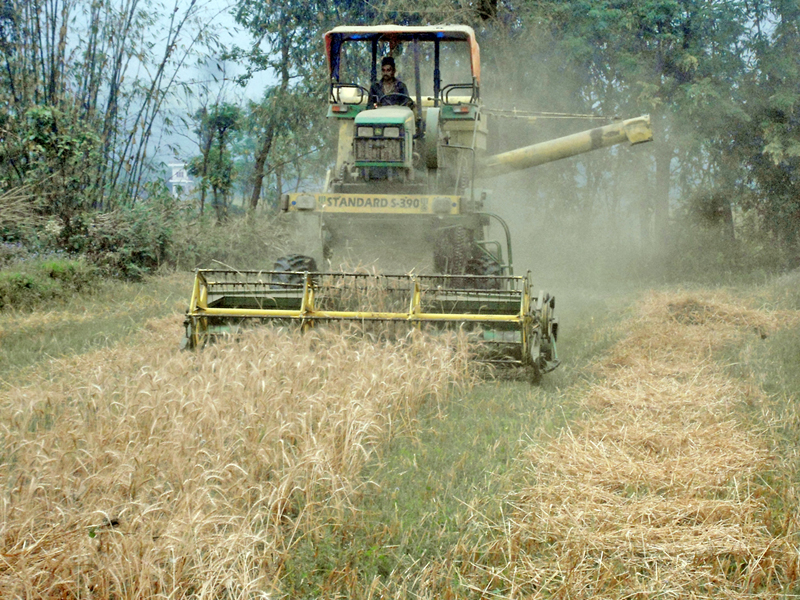Govt’s intervention policy aims to consolidate smallholder farmers to boost agro production
Kathmandu, May 31
As the domination of smallholder farmers is considered to be the major obstacle in expanding agriculture mechanisation in the country, the government has announced an intervention policy to consolidate smallholder farmers to boost agriculture production in the country.
The Prime Minister Agriculture Modernisation Project, which is going to be implemented from next fiscal, has aimed to consolidate farmers through cooperatives so that the drive of agriculture mechanisation and commercialisation can be accelerated.
The project has offered various grant schemes to the farmers to consolidate them in pocket areas, blocks, zones and super zones. As farmers will be consolidated under the schemes, the Ministry of Agricultural Development (MoAD) aims to upgrade pocket areas to blocks, blocks to zones and zones to super zones every year and also identify new ones.
According to Shankar Sapkota, joint spokesperson for the MoAD, at least 10 hectares of land is needed to identify it as ‘pocket area’; 100 hectares to be considered a ‘block’; 500 hectares to be termed as ‘zone’, while a ‘super zone’ makes up of 1,000 hectares of land mass.
Farmers consolidated in pocket areas, blocks, zones and super zones will have to follow the guidelines prepared by the MoAD to obtain grants and enjoy various offers announced by the fiscal budget 2016-17.
Pocket areas, blocks, zones and super zones need to give at least one specific crop production to support the government’s aim to be self-reliant in agriculture production (in which the country has the potential) within the next few years.
Further, the government has aimed to tame inflation caused by spike in food prices due to supply side constraints in the country by boosting domestic productivity.
The government will offer quality seeds, seedlings and fishlings, additional grants for chemical fertilisers, irrigation facilities and agriculture extension services for farmers in the identified pocket areas.
Apart from all the facilities extended to the pocket areas, farmers in block areas will get additional facilities like 50 per cent cash grant on purchase of agriculture inputs and 85 per cent cash grant for development of agriculture production collection centres, weekly local markets, primary processing centres, warehouses and agriculture production and processing training centres.
Likewise, zones will get additional facilities, including the facilities extended for pocket areas and blocks. The fiscal budget has offered 85 per cent cash grant to set up seed, seedlings and fishlings production centre and 50 per cent cash grant for processing centres, warehouses and cold storage facilities. The government will establish technical and vocational schools for agriculture entrepreneurs in the zones.
Similarly, super zones will get further facilities from the government, including all the facilities extended for pocket areas, blocks and zones. The budget has announced 85 per cent cash grant on seeds, seedling and fishlings production, organic fertiliser factories, and production of biopesticides. The government will extend soil testing facility and other required agriculture extension services in super zones. In addition, the fiscal budget 2016-17 has announced 50 per cent cash grant for modern agriculture processing centres, agriculture marts, cold storage facilities and warehouses and agriculture input factories in the super zones.
The fiscal budget has allocated Rs 5.78 billion for the grant distribution and agriculture extension services in the pocket areas, blocks, zones and super zones.
Through all these schemes, the government has tried to lure farmers’ cooperatives in production sector and private sector in processing, warehouse facility and agriculture input factories.
As per MoAD, the government will promote pocket areas along the Postal and Mid Hill Highways so that farmers will get easy access to the market. The government aims to develop around 2,100 pocket areas. Similarly, it has planned to set up at least two blocks in one district, 30 zones across the country and one super zone per province.
Super zones will be developed in Jhapa for paddy production; Kavre for potatoes; Bara for fishery; Kaski for vegetables; Dang for maize; Jumla for apples and Kailali for wheat.
To address other barriers in agriculture commercialisation, the fiscal budget has allocated substantive funds for small and mega irrigation projects and aimed to complete the irrigation projects that are under construction within three years.
Moreover, the fiscal budget has announced that the interest rate of agriculture credit will be lowered to five per cent and that farmers would be given 75 per cent premium subsidy for agriculture, livestock and fowl insurance. The budget has also launched production-based insurance scheme to minimise risk borne by farmers.
Quick look
- 2,100 pocket areas, 150 blocks, 30 zones and 7 super zones to be developed across the country
- Consolidated farmers will have to follow MoAD guidelines to obtain grants
- Such areas, zones will have to give at least one specific crop production to support government’s aim to be self-reliant in agriculture production in next few years
- Substantive funds allocated for small and mega irrigation projects
- Interest rate of agriculture credit lowered to 5pc
- 75pc premium subsidy for agriculture, livestock and fowl insurance






